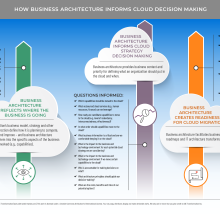As organizations world-wide embark upon their digital transformation journeys, the adoption of cloud has become a foundational enabler. In this installment of StraightTalk, we will explore how business architecture can be leveraged to provide the critical business context to inform decision-making around cloud strategy and migration.
What is the cloud all about again?
“A cloud is a communications network. However, the word cloud often refers to the Internet, which more precisely means a datacenter full of servers connected to the Internet performing a service. However, the term cloud computing refers to the software and services that have enabled the Internet to become so prominent in everyday life.”1
So, from a business perspective, the cloud matters significantly because it provides numerous benefits: reduced costs, increased business agility, improved flexibility to scale up or down, increased business continuity, enhanced collaboration across organizations and business ecosystems, as well as increased support for flexible work practices. All of these aspects can serve to enable better customer, partner and employee experiences — ultimately leading to improved business competitiveness.
Isn’t cloud strategy and decision-making just about the technology?
No, in fact, many of the challenges that organizations face when implementing cloud strategies is related to the lack of business involvement and perspective needed to drive the right direction and decisions and make sure that measurable business benefits are delivered in the end. Too often cloud is thought of as just technology – but it is an important enabler of the business.
How can business architecture be leveraged to inform cloud decision-making?
Here are just a few ways an organization can leverage its business architecture to inform decisions related to cloud strategy and migration. Hopefully they can inspire many more of your own ideas. A few themes are described in bold below as well as some questions business architecture can help answer along with key business architecture domains/focus areas in italics.
- Business architecture reflects where the business is going. An organization’s business model, strategy and other business direction define how it is planning to compete, transform and improve – and business architecture translates them into the specific aspects of the business which are involved (e.g., capabilities). Here are a few questions business architecture can help answer:
- What is the current business direction? [strategies, business model(s), products]
- Are there any planned structural changes, internal (e.g., new department) or external (e.g., merger, acquisition, divestiture, joint venture)? [strategies, business model(s), products, business units]
- What aspects of the business are involved to carry out this direction? [frame with and aggregate by value streams and capabilities]
- What external regulations and internal polices do we need to consider? [policies, capabilities, business units]
- Business architecture informs cloud strategy decision-making. Business architecture provides business context and priority for defining what an organization should put in the cloud and when. Here are a few questions business architecture can help answer:
- Which capabilities should be moved to the cloud? [value streams, capabilities and metrics]
- What outsourced cloud services (e.g., human resources, finance) can we leverage? [value streams, capabilities and metrics]
- What is the readiness for capabilities planned to move to the cloud? (e.g., level of redundancy, interconnectedness, effectiveness)? [value streams, capabilities, metrics + IT architecture alignment including applications and software services]
- In what order should capabilities move to the cloud? [value streams, capabilities, strategies, stakeholders, metrics]
- What business information is critical and are we comfortable keeping it in the cloud? [information, value streams and capabilities]
- What is the impact to the business and technology environment for each potential cloud strategy we are considering? [value streams and capabilities as focal points + ripple effect on all other business architecture domains including strategies, products, stakeholders, business units, information, policies and initiatives + ripple effect on customer journeys + operating model aspects such as processes and organizational roles and skills + IT architecture]
- What is the impact to the business and technology environment if we move certain capabilities to the cloud? [same as above]
- Who is accountable for making decisions on what? [value streams, capabilities, business units, stakeholders]
- What architecture principles should guide our decision-making? [focus on business and IT architecture principles such as when to be cloud-first]
- What are the costs, benefits and risks of our potential options? [leverage value streams and capabilities as a framework for analysis, visualization and communication]
- Business architecture creates readiness for cloud migration. Business architecture facilitates business-driven roadmaps and IT architecture transformation. Here are a few questions business architecture can help answer:
- How do we prepare our data so that it is consistent across silos? [information + data architecture alignment]
- How do we drive our IT architecture transformation (e.g., move to service-based) from a business perspective? [value streams, capabilities, strategies, metrics + IT architecture alignment including applications, software services and data architecture]
- Where do we have business misalignment and tech debt, and when should we remove it? [value streams, capabilities, strategies, metrics + IT architecture alignment including applications and software services]
- How do we define our cloud migration roadmaps and plans from a business perspective and harmonize them with other work across the organization? [value streams and capabilities to scope, frame and connect initiatives]
- Which business units and stakeholders will be impacted by these changes, how and when? [value streams, capabilities, business units, stakeholders, initiatives]
Check out the handy diagram below for a summary:
What is the role of a business architect in cloud decision-making?
In a nutshell, business architects help to ensure that their organizations make well-informed decisions about their cloud strategy, provider(s) and migration – from a business perspective – and for the right reasons. Business architects should be at the table right from the beginning, continually working hand-in-hand with business people and IT architects.
Here are some direct quotes from a leader at a large cloud provider during a session in March 2020:
“…Start with the business case and business involvement and include the business architect…” “…We have found that organizations that are successful with implementing cloud strategies have business architects involved from the beginning…” “…You have to map out what you do from a business architecture perspective and match it to what a cloud provider does…” “…The business architect is critical…”
There you have it – from a cloud provider who sees many, many successful (and not so successful) cloud implementations. Business architecture and business architects are key to success.
More Good Stuff...
Applying Business Architecture to the Cloud (Michael Rosen): A fundamental, BIZBOK® Guide-aligned presentation on this topic by a true architecture guru.
Is All-In on the Cloud a Real Strategy (Charles Arajuo): A practical, customer- and business-focused take on the all-in cloud strategy.
How to Turn Failing Cloud Investments Into Business Benefits (Hans Gillior): How to ensure investment in cloud supports business value and leads to a successful digital transformation.
Cloudy With a Chance of Joy (TED Talk): Just for fun. A TED Talk by Cloud Appreciation Society Founder, Gavin Pretor-Pinney, to make us wonder and find creative inspiration in the clouds (the real ones).
- 1Source: PCMag (https://www.pcmag.com/encyclopedia/term/cloud )

